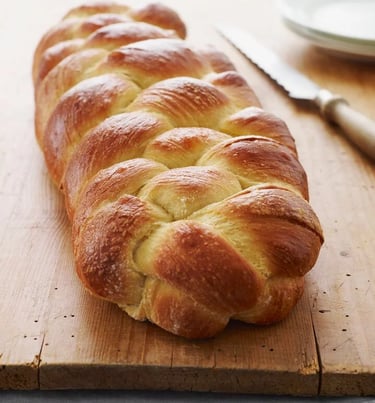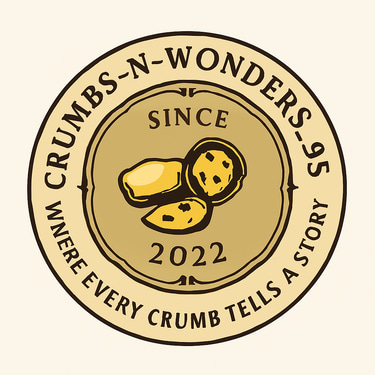CHALLAH BREAD
Challah bread, a braided egg bread central to Jewish traditions, has a history rooted in biblical times and evolving through various cultural adaptations. Making that iconic old time bread-soft , moist and fragrant.
KITCHEN FLAVORS
Wandering Armenian
6/25/20253 min read
🇮🇱 Challah Bread – A Golden Braid of History, Faith, and Flavor
Introduction:
There are recipes that nourish the body, and then there are those that feed the soul. Challah bread is the latter. I am a wayfarer—once a humanitarian aid worker journeying across continents from Haiti to Afghanistan, now a home baker guided by tradition, flavor, and faith. In all my travels, few things have embodied warmth and community like this golden, braided loaf. Each twist of the dough tells a story. It is this story I wish to share with you—not just of flour and yeast, but of heritage, rest, and remembrance.
History of the Cuisine:
Challah, pronounced HAH-lah, holds a deeply spiritual and communal place in Jewish culture. Its roots trace back to biblical times when a portion of dough—challah—was separated as an offering to the priests, signifying gratitude, and obedience. While the practice of offering evolved, the name and reverence for the bread endured.
By the medieval era, especially in Ashkenazi Jewish communities of Germany and Austria, the modern braided challah emerged—symbolic, celebratory, and reserved for the sacred day of rest, Shabbat, and holidays. The intertwined strands are said to represent love, truth, peace, or even the arms of angels embracing the Sabbath. In every generation, challah has connected families around the dinner table, through joy, remembrance, and blessing.
Ingredients:
4¼ cups all-purpose flour (plus more for dusting)
1 tablespoon instant/rapid-rise yeast
2 teaspoons salt
¾ cup lukewarm water
¼ cup + 2 tablespoons vegetable oil
¼ cup + 2 tablespoons honey
3 eggs, at room temperature
1 egg yolk, at room temperature
Optional: Poppy seeds or sesame seeds for garnish
Preparation Process:
Step 1: Mixing the Dough
In a stand mixer fitted with the dough hook, mix the flour, yeast, and salt on low speed. In a separate bowl, whisk the lukewarm water, oil, honey, two eggs, and one egg yolk. Pour into the dry mix and knead for 5–7 minutes until a sticky, elastic dough forms.
Step 2: First Rise
Turn the dough out onto a floured surface and shape it into a smooth ball. Place in a lightly oiled bowl, turning once to coat. Cover with plastic wrap and let rise in a warm place for 2–3 hours until doubled in size.
Step 3: Shaping the Braids
Place the dough on a floured surface and divide into four equal pieces (about 9 oz each). Roll each into 20-inch ropes. Pinch one end of the strands together, then begin braiding by taking the far-right strand and weaving it over, under, over the others. Repeat until fully braided. Tuck the ends under neatly.
Step 4: Final Rise and Bake
Place the braided loaf on a parchment-lined baking sheet. Cover loosely and let rise for 1–2 hours until puffy and about 1.5 times in size. Preheat the oven to 350°F.
Brush the loaf with the remaining beaten egg. Sprinkle with seeds if desired. To prevent over-browning, place the baking sheet on top of another sheet. Bake for 25–35 minutes until the top is rich golden brown and the internal temperature reads 190–200°F.
Cool on a rack before slicing. The aroma alone will make the wait worthwhile.
Nutritional Content (per slice, approx.):
Calories: 160
Carbohydrates: 25g
Protein: 4g
Fat: 5g
Cholesterol: 30mg
Sugar: 6g
Sodium: 150mg
Note: Values may vary depending on portion size and added toppings.
Pro Variation Tips:
For a richer loaf, replace water with warm milk.
Add raisins or dried cranberries for a festive touch.
Try a six-strand braid for visual flair and symbolic layering.
Use maple syrup instead of honey for a smoky-sweet twist.
Leftovers? Challah makes exceptional French toast or bread pudding.
Concluding Thoughts:
In every braid lies a blessing. As someone who has broken bread in tents, refugee camps, and joyful reunions, I know the simple act of sharing a slice can restore hope and dignity. This Challah is my tribute to that truth—a fragrant, golden embrace from my oven to your home.
I invite you not only to bake it, but to pause, reflect, and share it—perhaps at your next gathering or quiet Sabbath rest. Let it remind you that even in displacement, there is tradition. Even in sorrow, there is sweetness. And even in ordinary flour and oil, there can be extraordinary grace. The recipe I feel speaks to themes of hope, dignity, tradition, restoration, and grace through shared acts of nourishment and community. A scripture that resonates deeply with Isaiah 61:3 (NIV).



